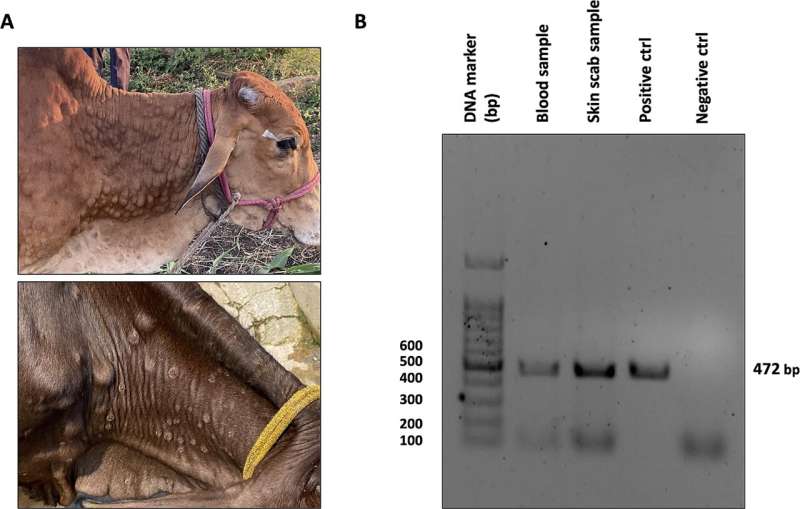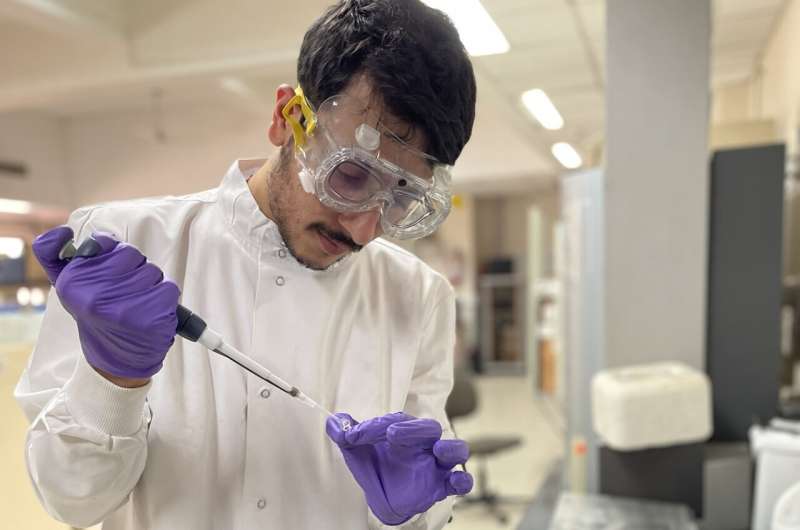This article has been reviewed according to Science X's editorial process and policies. Editors have highlighted the following attributes while ensuring the content's credibility:
fact-checked
peer-reviewed publication
trusted source
proofread
Tracking the virus behind India's lumpy skin cattle crisis

In May 2022, cattle across India began dying of a mysterious illness. Since then, about 1,00,000 cows have lost their lives to a devastating outbreak of what scientists have identified as lumpy skin disease. The outbreak has severely affected India's agricultural sector, leading to staggering economic losses.
"It was a calamity in some ways … a national emergency," says Utpal Tatu, Professor in the Department of Biochemistry, Indian Institute of Science (IISc).
Tatu is part of a multi-institutional team that decided to probe the cause of the outbreak. Their study, published in BMC Genomics, provides critical insights into the evolution and origins of the virus strains fueling it.
A viral infection caused by the Lumpy Skin Disease Virus (LSDV), the disease is transmitted by insects such as flies and mosquitoes. It causes fever and skin nodules, and can be fatal for cattle. LSDV was first found in Zambia in 1931 and remained confined to the Sub-African region until 1989, after which it started spreading to the Middle East, Russia and other southeast European nations, before spreading to South Asia. There have been two major outbreaks of this disease in India, the first in 2019 and a more severe outbreak in 2022, infecting more than 2 million cows.
To investigate the current outbreak, the team collected skin nodules, blood and nasal swabs from infected cattle in various states, including Gujarat, Maharashtra, Rajasthan and Karnataka, in collaboration with veterinary institutes. They performed advanced whole-genome sequencing of DNA extracted from 22 samples.
"The biggest challenge was the lack of an established LSDV genome sequencing and analysis pipeline. We had to adapt techniques from COVID-19 research," explains Ankeet Kumar, Ph.D. student at IISc and co-lead author. "Data was also limited, so we compiled all available global LSDV genome sequences to make our analysis robust."

Their genomic analysis revealed two distinct LSDV variants circulating in India, one with a low number of genetic variations and another with a high number of genetic variations. The sequence with fewer variations was genetically similar to the 2019 Ranchi and 2020 Hyderabad strains that were sequenced previously. The samples with high variations, however, turned out to be similar to LSDV strains from an outbreak in Russia in 2015.
Kumar says that there are no previous reports of such highly varied LSDV strains in India. Viruses that have DNA as the genetic material—like LSDV—are generally more stable than RNA viruses. Therefore, finding so many genetic variations was quite surprising, and could explain the severity of the disease, he adds.
The team found a large number of genetic variations—more than 1,800. These include deletions and insertions in various genes, single-letter changes in DNA (called SNPs), and genetic variations in regions between genes. Importantly, they found a large number of genetic variations in viral genes critical for binding to host cells, evading immune response, and replicating efficiently. This likely enhanced the virus's ability to cause disease.
"Cattle developed more severe symptoms in areas where we found highly diverse strains. This suggests that the genetic variations could elevate virulence," says Kumar.
Such insights can pave the way for improved diagnostics, vaccines and interventions to combat emerging infectious diseases that threaten livestock and livelihoods. Tatu's research group has conducted similar studies on COVID-19 during the pandemic, and more recently on the rabies virus.
"The genomic data will prove invaluable for vaccine development by revealing molecular hotspots and genetic variations to target," notes Tatu. "This is a first for characterizing the genomic landscape of LSDV during India's outbreak on a national scale."
The study represents an example of the One Health approach in which multidisciplinary teams, including molecular biologists, computational experts and veterinary doctors come together to address issues of national relevance.
Tatu also emphasizes how collaboration between veterinary experts and multiple scientific institutions was critical to tracing the variants across the country. "We learned a lot from the veterinary doctors," he says. "They understand the field knowledge, and their perception about the disease was very important for us."
More information: Priya Yadav et al, Unravelling the genomic origins of lumpy skin disease virus in recent outbreaks, BMC Genomics (2024). DOI: 10.1186/s12864-024-10061-3
Journal information: BMC Genomics
Provided by Indian Institute of Science





















